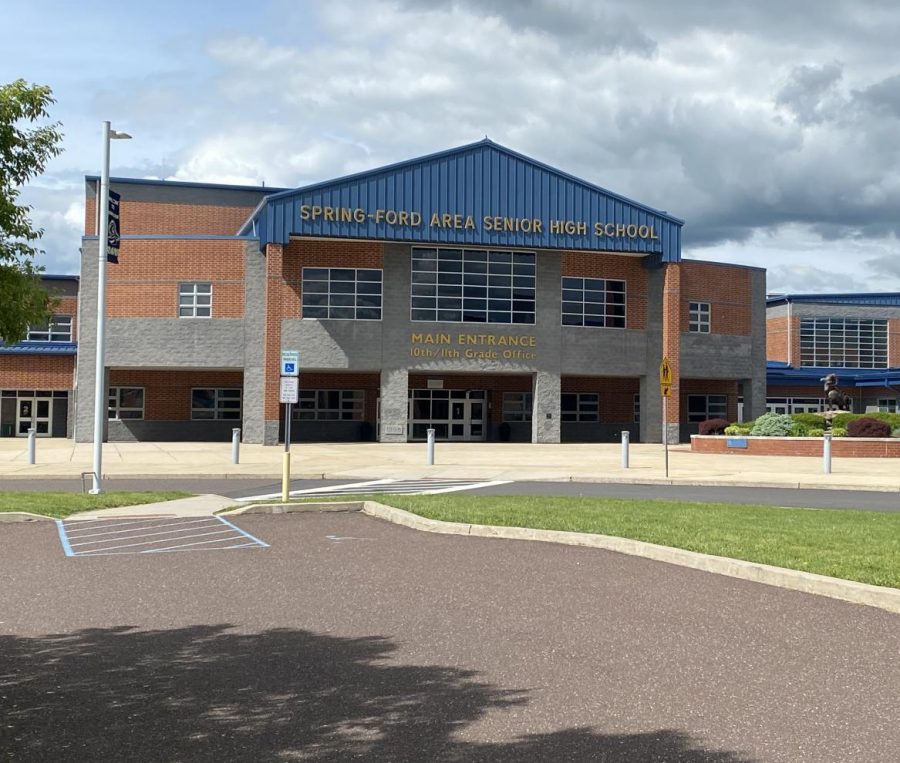SF high school headed to hybrid
Grades Kindergarten through 6th grade will return for full-time, in-person instruction. Grades 7-12 will follow suit using the hybrid reopening model.
The Spring-Ford School Board voted Jan. 19 to move students in grades 7-12 from the current In-Person, Hybrid Model to an In-Person, 4-Day Model starting Feb. 4.
November 4, 2020
Walking into school on the first day is both an exhilarating and nerve-wracking experience for students. Whether it is your first year in the building or your last, the build-up to the first day of school is the same.
Spring-Ford Area School District students found themselves prepping for their first day of school in a different way this year, however. As the COVID-19 pandemic ran rampant across the world, many norms surrounding schooling plans changed dramatically for the fall of 2020.
That new reality led to the Spring-Ford Area School District deciding to start the 2020-21 school year virtually. And although most understood the decision, many seniors were disappointed.
“ While I wanted to be in school, I understood remaining virtual was a necessary step to protect the lives of students, teachers, and families alike,” senior Megan Sharkey said.
Spring-Ford began the process of resuming in-person learning when the school board voted Oct. 5 in favor of reopening the schools through a combination of in-person and hybrid programs later this month.
Under the plan, grades Kindergarten through 6th grade will return for full-time, in-person instruction starting Nov. 12. Grades 7-9 will follow suit using the hybrid reopening model Nov. 12 as well. Beginning on Nov. 16, grades 10-12 will return following the same hybrid plan as 7-9.
In a hybrid reopening, students will return in-person to the school in waves. Split into two groups, the Blue Group will be present in the building on Monday and Thursday while the Gold Group is following classes through Zoom or pre-recorded videos. These groups will then switch on Tuesday and Friday. Wednesdays will remain an asynchronous day on Canvas for all students.
As an additional option, high school students could choose to remain virtual. Instead of returning to classes on alternating days under the hybrid plan, those students would remain in their classes virtually all five days of the school week like they are currently.
The return via hybrid provides students with some sense of normalcy.
“I’m excited to return to school, although I am still a little nervous,” junior Ariel Haley said. “I think most people didn’t appreciate in-person learning until it was taken away from them, so they are excited to have a major aspect of their life almost back to normal.”
While the return to in-person learning is highly anticipated, it will not come without challenges and precautions. Safety is a key to the return, as explained in the school and state recommendations for school return.
“We recognize and are doing a lot of things to work within those guidelines,” Spring-Ford High School Principal Dr. Robert Colyer said. “We certainly recognize that in a building our size social distancing will not happen at every moment, but that is why we will be wearing masks at all times.”
What other accommodations will be made as students return for hybrid learning? Many of the classrooms and key areas of the school have been equipped to follow guidelines set out to protect against COVID-19, including hand sanitizer in every classroom, plastic sneeze guards in office areas, wipes for student use, and spacing 6-feet apart in the cafeteria.
However, there is still concern by some that these changes may not be enough.
“With the flu season coming up, the spiking of cases in our area, and college students returning home, I feel like right now is not the time for us to be opening our doors and allowing thousands of students in at once,” Sharkey said.
According to reopening plans, should a student experience symptoms throughout the school day they will immediately be sent to the health annex and isolated from other students. From there, the school’s health officials will determine, depending on each case, whether they should be tested for the virus and quarantine at home.
If a student tests positive for the virus, they may only return to school after 24 hours symptom free and at least 10 days from when symptoms first appeared. If a student tests negative or receives a doctor’s note with an alternate diagnosis, they may return to school 24 hours after improved respiratory symptoms.
To assist in the process of contact tracing, an individual within 6 feet for 15 minutes or more of someone who receives a positive test result must quarantine for 14 days. If they become symptomatic, they should test for COVID-19. If someone lives in the same household as someone who tested positive for COVID-19, they must quarantine until 14 days after the positive household member is released from isolation.
However, steps can be taken prior to arrival at school to ensure student safety. Each morning, students as well as staff will answer a series of questions from a checklist concerning their health. Should they have one of the symptoms including fever, cough, shortness of breath, difficulty breathing, and loss of taste or smell, students must not be sent to school.
Due to the size of the building and amount of students, the Spring-Ford community is beginning a daunting task of reopening the schools. Yet, by working together, the school will be able to overcome this challenge.
“These are shared responsibilities,” Colyer said. “We are a community here and we all need to take care of ourselves and practice good health and safety habits. It is a shared effort.”
The school asks that students be mindful of their own efforts to wash hands, wear masks, and social distance to keep themselves and fellow students safe. Nevertheless, the community is excited for students to come back and engage in in person learning to make the most of their education.

